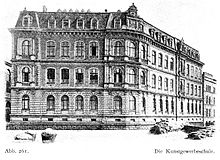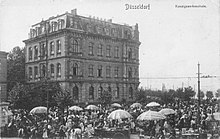Kunstgewerbeschule Düsseldorf
The Düsseldorf School of Applied Arts was opened on April 3, 1883 and closed at the end of the 1918 school year. Her architectural training was transferred to the Düsseldorf Art Academy in 1919 .
Training offer
The training focused on applied arts . Another focus was on the training of architects . The prerequisites for admission to the architecture department were previous studies at a building trade school or university or proof of “sufficient technical experience and knowledge”. The school consisted of three departments: pre-school, technical school, evening school. The classes included freehand drawing, geometric drawing and ornamental shape theory. In addition, the school ran writing courses from 1905 onwards, which were linked to studies of the history and aesthetics of artistic writing. For this purpose, the school had contacted the British calligrapher Edward Johnston . On his behalf, Johnston's student Anna Simons directed the writing courses in Düsseldorf. The course participants came from all parts of the German Reich.
financing
The cost of the school, whose statute was approved by the responsible minister on February 28, 1882, was borne by the city of Düsseldorf , which initially received an annual government grant of 7,830 marks, which was increased to 30,000 marks annually by 1900.
history
The first director of the school was the architect Hermann Stiller from 1884 to 1903. The arts and crafts school experienced a heyday in the years 1903 to 1907. During this time it was headed by Peter Behrens , who - as his appointment wanted - with a new organization and implemented his own ideas in the direction of teaching and repositioned the university compared to the architecture training at the Düsseldorf Art Academy. Behrens brought new teachers to the School of Applied Arts: Rudolf Bosselt , Fritz Helmuth Ehmcke and Max Benirschke . Despite only four years of activity in Düsseldorf, Behrens left lasting traces there. 1907 brought him Emil Rathenau as artistic consultant and designer of industrial products ( designers ) to AEG . In 1909 Lothar von Kunowski became head of the "state drawing teacher seminar" at the School of Applied Arts.
From 1908 to 1919 the School of Applied Arts was under the directorate of Wilhelm Kreis , who had applied for this post in 1902. Fritz Schumacher , who was originally supposed to take over the directorate from Behrens, had accepted the position of Hamburg construction director. The founding of an architecture department at the Düsseldorf School of Applied Arts was initiated in 1909 by Wilhelm Kreis. The special architecture department in Düsseldorf initially existed alongside the arts and crafts school. In the new architecture department of the School of Applied Arts, Kreis initially set up three separate architecture classes. The first class was devoted to “simple bourgeois construction” and was headed by government master builder Fritz Becker , who implemented several residential construction projects in the 1920s. Fritz Becker's architecture class was intended for building assignments for which the building contract was precisely fixed beforehand, from “simple workers' houses to better town houses and simple country houses, colonies, small business houses, agricultural buildings, small town halls and churches for small and medium-sized towns”. The architect Emil Fahrenkamp took over the second class of the architecture department for "interior design and building detailing" . Kreis took on the third architecture class for "monumental buildings".
In addition to the three large architecture classes, Kreis set up four more classes that were supposed to expand and enrich the teaching and to focus on the “architectural whole” and to integrate painting, sculpture, garden design and arts and crafts into the curriculum. Richard Klapheck took over the lectures on building history, town planning, monument preservation and homeland security in the class for “theoretical supplementary lessons”. In the “Sculpture Class”, the sculptor Hubert Netzer taught the use of sculpture and painting in architecture. Baron Walter von Engelhardt took over the management of the "garden art class" . Attendance at a state-recognized horticultural college was a prerequisite for admission. In addition to Engelhardt, Kreis, Becker and Fahrenkamp also took on teaching units on architectural garden design and garden equipment. With the establishment of the architecture department, the arts and crafts school had moved away from the original type of arts and crafts schools and had evolved into an architecture college. A class in conceptual drawing, nature studies and life drawing was set up for women, led by Josef Bruckmüller (1880–1932).
The First World War significantly reduced both the number of teachers and the number of students. Wilhelm Kreis, the director, was drafted into the army. In 1917, Richard Klapheck, a teacher of the history of art and architecture, was offered a position at the Düsseldorf Art Academy, which further weakened the teaching staff. At the same time, some teachers, including the architect Emil Fahrenkamp, had returned from the war. Nevertheless, several departments soon had to be closed. The last school year at the Düsseldorf School of Applied Arts ended in 1918.
In 1919, after the School of Applied Arts was closed, its most important component, architecture training, was transferred to the Düsseldorf Art Academy, which accepted both lecturers and students. The design of the “Department of Church Art” as well as the accommodation of the “State Drawing Teachers' Seminar” and the “Women's Art School” were also housed in the building of the art academy.
building
Main article: Düsseldorf School of Applied Arts (building)
The rooms of the technical college or university were housed in a new building erected in 1882/83 on Burgplatz in Düsseldorf's old town .
Today the building belongs to the Düsseldorf City Hall . Since 2005, five room segments of the building with around 650 m² of usable space, plus office and storage space, have been used by the Akademie-Galerie - Die Neue Sammlung of the Art Academy Düsseldorf. Two exhibitions are to take place there every year. a. on the work of the Düsseldorf academy professors after 1945. It is also planned to set up an archive on the bequests, information and publications of the teachers of the art academy.
Teacher
See: Category: University professors (Düsseldorf School of Applied Arts)
Students / alumni
- Hanna Achenbach (1892–1982)
- Sibylle Ascheberg of Bamberg (1888–1966)
- Carl Josef Barth (1896–1976)
- August Bauer (1868–1961)
- Robert Dudley Best (1892-1984)
- Paul Bindel (1894–1973)
- Eva Brinkman (1896–1977)
- Ferdinand Carl Cürten (1892–1945)
- Fritz August Breuhaus de Groot (1883–1960)
- John Dähmcke (1887–1980)
- Carl Deiker (1879-1958)
- Heinrich Ehmsen (1886–1964)
- Joseph Enseling (1886–1957)
- Julius Freymuth (1881–1961)
- Wilhelm Gdanietz (1893–1969)
- Bruno Gimpel (1886–1943)
- Irma Goecke (1895–1976)
- August Hagen (1875–1944)
- Georg Hambüchen (1901–1971)
- Wilhelm Hambüchen (1869–1939)
- Heinrich Hamm (1889–1968)
- Carl Hemming (1867 – after 1924)
- Max Hertwig (1881–1975)
- Ferdinand Heseding (1893–1961)
- Albert Herzfeld (1865–1943)
- Robert Högfeldt (1894–1986)
- Alfred Holler (1888–1954)
- Ludwig ten Hompel (1887–1932)
- Willy Robert Huth (1890–1977)
- Heinrich Kamps (1896–1954)
- Karl Köster (1883–1975)
- Leo Küppers (1880–1946)
- Carl Lambertz (1910–1996)
- Leon Lauffs (1883-1956)
- Max Lazarus (1892–1961)
- August Macke (1887–1914)
- Adolf Meyer (1881–1929)
- Wilhelm Mohr (1882–1948)
- Traugott Müller (1895–1944)
- Gustav August Munzer (1887–1973)
- August Oppenberg (1896–1971)
- Emil Pohle (1885–1962)
- Robert Pudlich (1905–1962)
- Willy Reetz (1892–1963)
- Hans Rilke (1891-1946)
- Marcel Wilhelm Richter (1886–1966)
- Wilhelm Ritterbach (1878–1940)
- Robert Sandfort (1880–1945)
- Lore Schill (1890–1968)
- Herbert Rolf Schlegel (1889–1972)
- Friedrich Hermann Ernst Schneidler (1882–1956)
- Hermann Sehrig (1892–1963)
- Eduard Sturm (1885–1952)
- Arnold Topp (1887–1945, missing)
- Adolf Uzarski (1885–1970)
- Walter von Wecus (1893–1977)
- Anton Wendling (1891–1965)
- Jakob Weitz (1888–1971)
- Paul Westerfrölke (1886–1975)
- Bernhard Weyrather (1886–1946)
- Gertrud Weyrather-Engau (1876–1950)
- Albert Wigand (1890–1978)
- Franz Xaver Wimmer (1881–1937)
- Louis Ziercke (1887–1945)
literature
- Report on the Düsseldorf School of Applied Arts . Düsseldorf, 1893–1902 ( digitized version )
- Annual report . Düsseldorf, 1903–1909 ( digitized version )
- Report: about the school year ... Düsseldorf, 1910–1914 ( digital copy )
- Gisela Moeller: Peter Behrens in Düsseldorf. The years from 1903 to 1907 . VCH-Verlag, Weimheim 1991, ISBN 3-527-17726-4 .
- Frank's Great War (2014), by Robert Best: contains a chapter about Robert Best's year as a student at the Kunstgewerbeschule and from 1911 to 1912 on the musical culture and family life of Düsseldorf.
- Holger Rescher: The architecture department of the arts and crafts school in brick architecture of the 1920s in Düsseldorf (dissertation)
Individual evidence
- ^ Arne Ehmann: Residential architecture of Central European traditionalism around 1900 in selected examples. Considerations on the typology, aesthetics and building history of traditionalist building . Dissertation University of Hamburg, Hamburg 2006, p. 135 ( file in PDF )
- ^ Wilhelm Schäfer : The new arts and crafts school in Düsseldorf . In: Die Rheinlande , Volume 7, Issue 1 (October 1903), p. 62 ( digitized version )
- ^ School of Applied Arts with a special architecture department, Burgplatz 1, director: Wilhelm Kreis; Teachers: painter Ignaz Wagner, painter Prof. Friedrich Neuhaus, painter Prof. W. Sprengel, architect Prof. Joh. Hermanns, painter A. Hochreiter, painter Professor L. Heupel-Siegen, sculptor Prof. Hubert Netzer, painter FH Ehmcke, architect W. Benirschke, painter J. Bruckmüller, gardening director Freiherr W. von Engelhardt, librarian Dr. Richard Klapheck, painter W. Hartz, architect Emil Fahrenkamp (assistant), engineer Karl Frohn,, in address book for the city of Düsseldorf, 1912, art institutes, p. 37
- ↑ Friedrich Tamms : Of people, cities and bridges . Econ Verlag, Düsseldorf 1974, ISBN 3-430-19004-5 , pp. 22, 23
- ↑ Kunstgewerbeschule Düsseldorf, University of Cologne, signature: 1021/42 - BR 1021, vol. 1, file number: 69/47 ( Memento of the original from January 29, 2008 in the Internet Archive ) Info: The archive link was inserted automatically and has not yet been checked. Please check the original and archive link according to the instructions and then remove this notice.
- ^ Akademie-Galerie - Die Neue Sammlung , article in the portal kunstakademie-duesseldorf.de , accessed on September 29, 2013
- ↑ Holger Rescher: Brick architecture of the 1920s in Düsseldorf Bonn 2001, p. 39
Coordinates: 51 ° 13 '36.6 " N , 6 ° 46' 17.4" E


